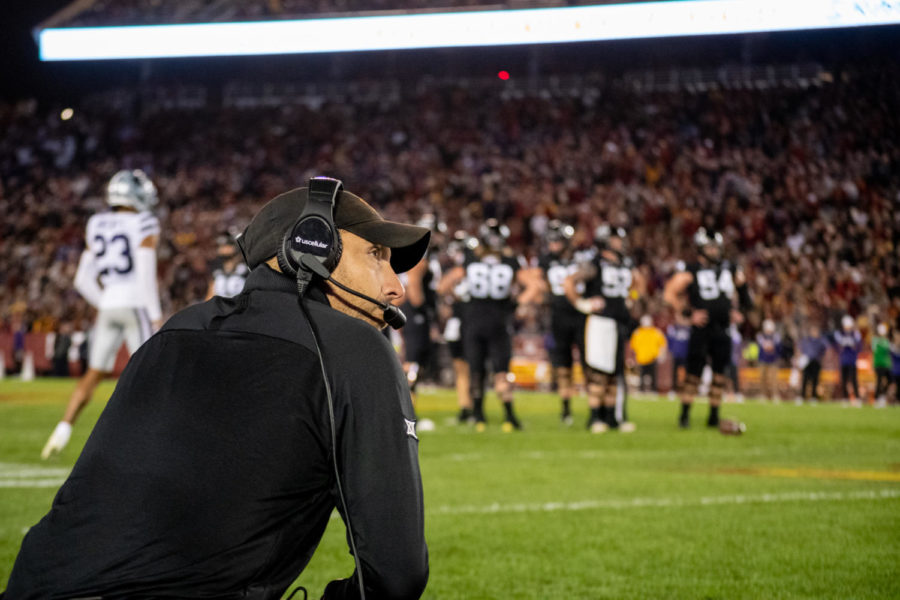Royston: What does the future hold for the new Big 12?
Matt Campbell checks the scoreboard in 10-9 loss to Kansas State on Oct. 8.
With the NCAA Outdoor Championships wrapped up, Texas added another accolade to its ever-growing list as the Longhorns took the women’s track and field national title.
Not only did the Longhorns take the national title at the Outdoor Championships, but they took it by a landslide. Texas took the title with a team score of 83. The next closest team was Florida, with 51.
Not long before track and field finished up, Oklahoma made headlines as it swept the Women’s College World Series. The Sooners capped off their three-peat by extending their winning streak to 53—an NCAA record.
Although fans of the Big 12 can celebrate these historic achievements now, the end is near. By this time next year, both Texas and Oklahoma will officially be in the Southeastern Conference (SEC).
So that begs the question, what will the Big 12 be missing when two powerhouse schools leave the conference, and what does the future look like with the incoming schools?
Love them or hate them, the Longhorns and the Sooners brought high-level competition across all collegiate sports. From Oklahoma terrorizing the conference in football in recent years to Texas dominating the basketball scene, both schools always gave other Big 12 schools a lot to strive toward.
Every team in the conference wanted to beat Texas and Oklahoma. It was incredibly evident from the atmospheres surrounding every home matchup against the two. There is a change in demeanor when going up against those two schools that doesn’t exist in smaller rivalries.
Along with the big sports, the Longhorns and the Sooners frequently found themselves at the top of nearly every smaller sport.
Texas dominated women’s tennis, sitting at the top of the rankings through most of the year. Oklahoma dominated gymnastics, marching to yet another national title.
Across the board, Texas and Oklahoma ran the Big 12. As much as fans of other schools don’t want to admit it, Texas and Oklahoma were consistent powerhouses in nearly every collegiate sport.
With one year left of competition between Texas and Oklahoma and the Big 12, this will be the final time that the two schools will leave their marks on the conference. Along with that, the four incoming schools—Cincinnati, Houston, UCF and BYU—should add another level of competition to next year’s sports across the board that might not be seen for years to come.
Next year should also be a glimpse of what the future looks like for the Big 12. Iowa State gets the chance to test the waters against a couple of the new schools in football as the Cyclones take on Cincinnati and BYU. They also get one last chance to relive the rivalries against Texas and Oklahoma.
As Texas and Oklahoma start to drift out of the conference, it will be interesting to see the level of competitiveness that the four new schools bring. All of them have their different strengths in different sports while being well-rounded in general.
Houston has been a powerhouse in the basketball scene, consistently marching deep through the NCAA Tournament in recent years. The Cougars also sprinted to a 12-2 finish in football in the 2021 season, finishing the year with a bowl game win over Auburn.
Cincinnati has been a team on the rise as well. The Bearcats made an appearance in the College Football Playoffs after an undefeated 2021 season, where they fell to the top-ranked team Alabama.
UCF is also a school on the rise, with the football team looking to make waves in its new conference. In the same vein, BYU has been a solid football team for years, making a bowl game for five straight seasons.
As the football season approaches, the Big 12 looks to be one of the most competitive conferences in the nation. As the four new teams enter the fray and Texas and Oklahoma look for one last hurrah, there’s no telling how next season will look.
However, one thing is for sure. The future of the Big 12 is bright.
Your donation will support the student journalists of the Iowa State Daily. Your contribution will allow us to purchase equipment, send our student journalists to conferences and off-set their cost of living so they can continue to do best-in-the-nation work at the Iowa State Daily.












